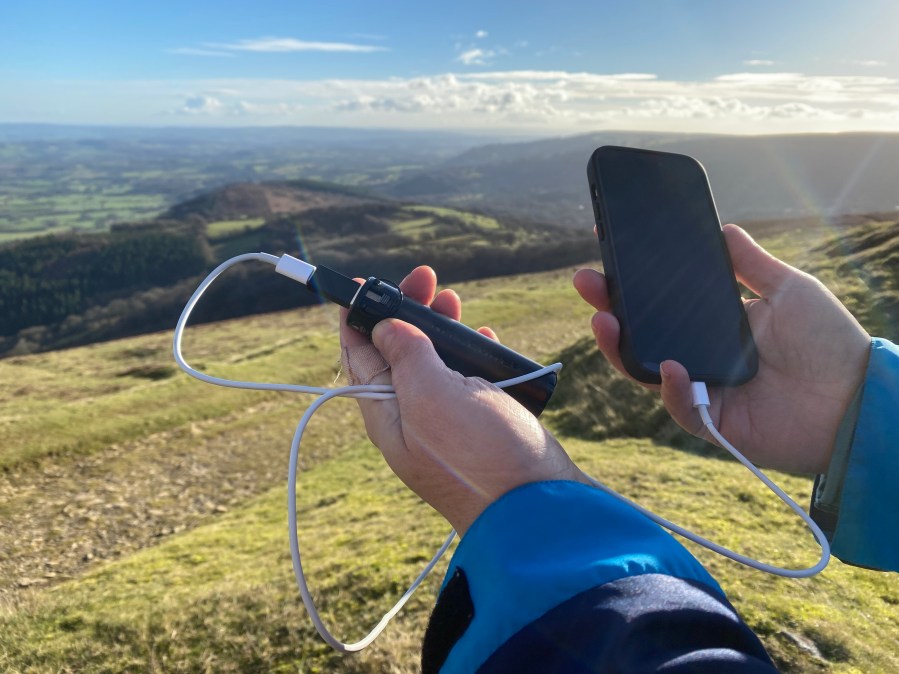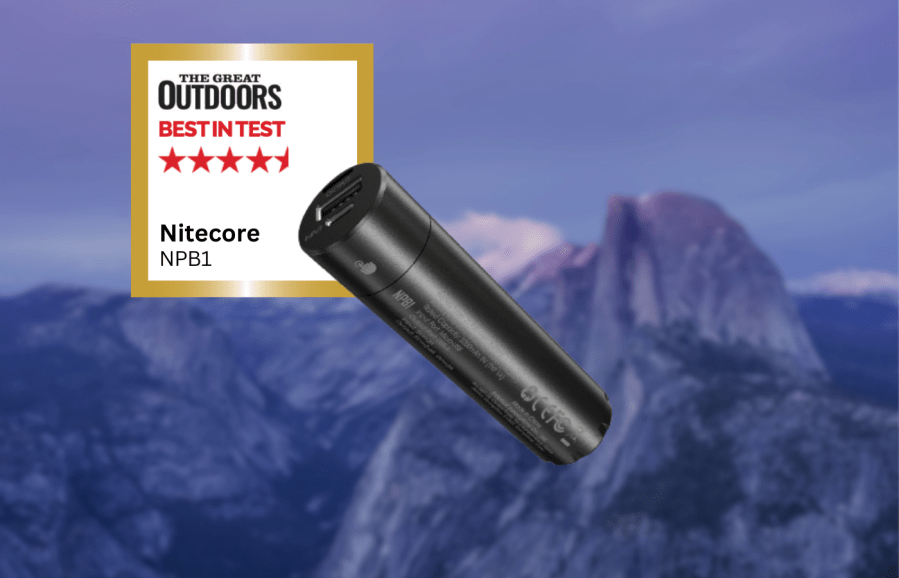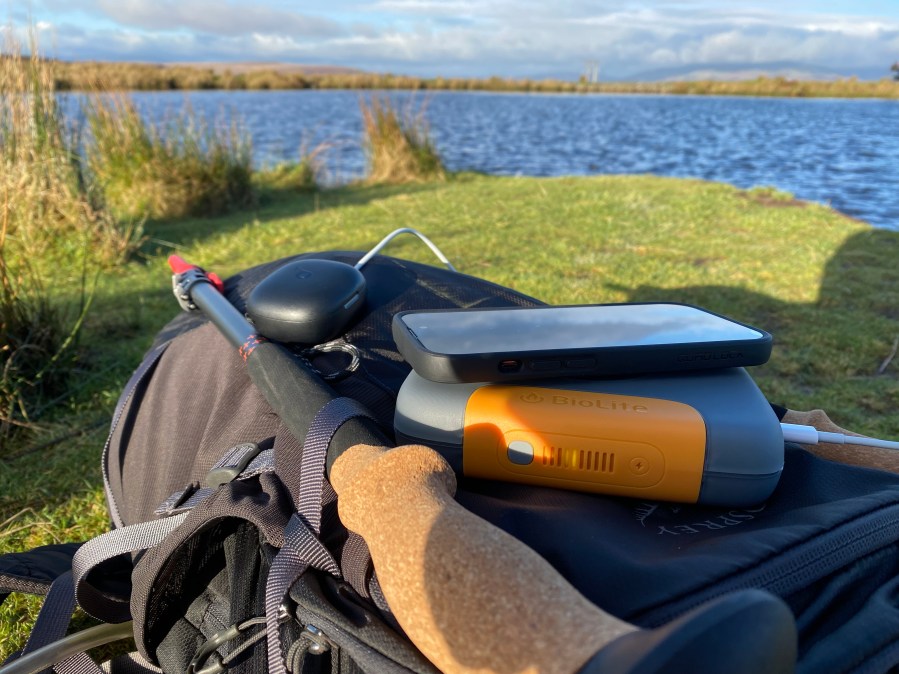



Have you ever unexpectedly run low on phone battery while in the mountains? Perhaps you’ve been out for longer than expected, tried a new app that has used up more battery than anticipated, or been over enthusiastic with how many photos you’ve taken. Selecting the best power bank for you can not only minimise technological faff on the hills, but can also be the difference between safety and an escalating emergency situation.
Main image: Steph testing the Anker power bank | Credit: Steph Wetherell
The reality is that we are increasingly reliant on tech in the outdoors, with our phones often being used for photography, navigation and safety as we venture into the mountains. Added to this, people are frequently carrying other kit that needs power – for cameras, lighting or entertainment – with them on adventures. This means that carrying a backup source of power has become a priority for many of us.
A power bank is basically a portable battery to allow you to easily charge devices on the move. For me, I like to carry a small power bank on most of my walks as while I often use paper maps while walking, I use my phone to navigate to and from the start of a walk. In addition, as someone who regularly walks alone, it is my primary route for calling for help if I get into trouble.

However, as a lover of long distance walking, I am also a fan of a larger capacity power bank that can keep me in touch with the world for days at a time if I’m out in the wilderness. If you carry equipment like cameras or drones with you, it can also be useful to be able to charge these devices on the move to avoid having to carry too many spare batteries.
Whether you’re looking for an emergency piece of kit or a planned recharge, there’s a range of different models and capacities available. However, considering what you want it for and the features you need will help identify the right option for you.

Steph Wetherell’s Best in Test
This is small and light enough to not notice the extra weight, but make sure you carry the right cables.- waterproof
- small
- light
- no USB-C port
| Quick specs |
|---|
| Price: £39.95 |
| Weight: 110g |
| Dimensions: 26.9 x 102.4mm |
| Features: Output: 1 x USB-A, Input: Micro-USB |
| Sizes: 5,000mAh (20,000mAh option also available) |
| www.nitecore.co.uk |
The Nitecore NPB1 is a lightweight and portable power bank, its shape and size making it small enough to carry in a coat or rucksack pocket for easy access. It is also waterproof (to an impressive 30 minutes of up to 2m submersion), meaning you don’t have to worry about having it out in the rain or keeping it in a dry bag. The 5,000mAh capacity was enough to fully charge my phone once.
The main downside is that it doesn’t have a USB-C port (only a USB-A and microUSB) and the maximum output power is 18W. This means it wasn’t particularly quick to charge my phone and feels like it might suffer with cable compatibility issues in the long term as there is a growing shift to USB-C cables. This is a power bank that is perfect to carry on day or overnight walks as it’s small and light enough to not notice the extra weight, but make sure you carry the right cables.
Read more: Steph Wetherell’s full Nitecore NPB1 review

Peter Macfarlane recommends
A lighter model may suit you but the Juice Holder’s performance and reliability has been a source of confidence- long battery life
- simple operation
- heavy
| Quick specs |
|---|
| Price: £29.99 |
| Weight: 438g |
| Materials: aluminium case |
| Features: IP65 water resistant rating, various plug in ports, LED indicator lights |
| Sizes: smaller capacity and lighter sizes are available |
| alpkit.com |
This shift in approach to powering adventures with devices makes power a high safety priority for me and I’ve been carrying the Alpkit Juice Holder, a large capacity power bank with 20,000mAh of stored power across its two internal batteries. Despite the additional weight I’d be carrying I chose the larger Alpkit Juice Holder size to cover all the potential needs I’d face over a number of days in the hills or with a group. With it, I’ve found myself charging two things simultaneously many times.
A lighter model might have been better but the Juice Holders performance and reliability has been a source of confidence.
Read more: Peter Macfarlane’s full Alpkit Juice Holder Power Bank review

Power capacity
Power bank capacity is measured in milliampere-hours (mAh), and gives you an idea of how much charge the battery holds. This is an important factor to consider when buying a power bank as will vary depending on if you’re looking for something as an emergency backup, or to provide you with reliable power for days at a time. For reference, many modern phones require a power bank of around 5,000mAh to fully charge them once.
Weight
You can expect the weight of a power bank to increase as the power capacity increases, as the primary weight of the device is the batteries it contains. Therefore this is a key factor to consider, especially if you’re looking to reduce or limit the weight you’re carrying on a trip.
Ports
A key factor in picking a power bank is deciding which charging ports you want, and how many devices you want to be able to simultaneously charge. While all banks will have a more traditional USB-A output port, many devices are now coming with a USB-C port that allows faster charging, so it can be worth looking for a power bank with this output if speedy charging is important. Many banks now also use the USB-C port as the input point for charging the bank. Another key question is how many devices you want to charge at the same time, with some power banks equipped with multiple output ports and wireless pads. Do check the maximum total output power though, as charging more devices simultaneously may reduce the power to each.
Durability
The outdoors environment is not always friendly to electronic devices, but how durable the power bank needs to be will depend on how your transport it. A waterproof device can be useful if you want access to it on the move, but if you’re charging in your camp and it’ll be packed in a drybag deep in your bag, this may be less of a priority.
Steph tested these power banks were tested out and about on the hills and mountains in the Brecon Beacons and the Peak District. Steph used them with her iPhone 14 Pro, which is a few years old, and a USB-C cable where possible. This comparative review was first published in the April 2024 issue of The Great Outdoors.
Peter carried and used items from his review of emergency kit, first published in the December 2024 issue of The Great Outdoors, on all of his hill trips throughout 2023 from one winter into the next. This ranged from Munro days to low level trails and he also used the gear multiple times on ranger duties in the Kilpatrick Hills. All weights are from the reviewer’s digital scales.

